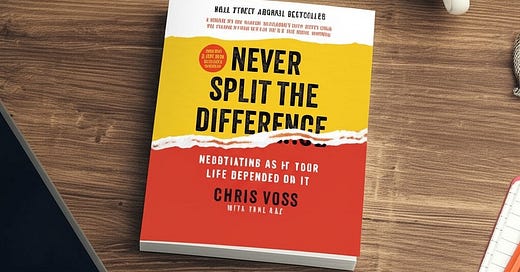10 Proven Negotiation Lessons from ‘Never Split the Difference’ by Chris Voss: Master Tactical Empathy, Calibrated Questions, and More
Objective:
The goal of this analysis is to extract and discuss the core lessons from Chris Voss’s book Never Split the Difference, which provides practical guidance on negotiation tactics drawn from Voss’s extensive experience as an FBI hostage negotiator. This summary aims to empower readers by outlining actionable steps for enhancing their negotiation skills in both personal and professional settings.
Brief Overview:
Never Split the Difference by Chris Voss is a deep dive into the art of negotiation, informed by the author’s unique background as a former FBI hostage negotiator. The book is designed to shift conventional thinking about negotiation, emphasizing that compromise is often not the best solution. Voss presents a series of techniques that challenge the traditional “win-win” approach, instead advocating for tactical empathy, calibrated questions, and an understanding of human psychology to achieve better outcomes. His style is engaging, blending real-life anecdotes with practical advice, making complex negotiation strategies accessible and actionable.
Lesson Highlights:
1. Tactical Empathy:
This lesson emphasizes understanding the emotions and perspectives of the other party in a negotiation. Voss encourages readers to practice “tactical empathy,” which involves actively listening and acknowledging the other party’s feelings. This approach not only builds rapport but also disarms the other side, making them more likely to cooperate.
2. The Power of Mirroring:
Highlighting the importance of subtle communication tactics, this lesson teaches the art of mirroring—repeating the last few words the other person said. This technique fosters connection and encourages the other person to continue speaking, revealing more information that can be critical in negotiations.
3. Labeling Emotions:
This lesson addresses the challenge of dealing with strong emotions during negotiations. Voss suggests that readers should label these emotions, saying something like, “It seems like you’re feeling…” to acknowledge the other party’s emotional state. This strategy helps to defuse tension and creates a more conducive environment for negotiation.
4. Calibrated Questions:
Focusing on the importance of asking the right questions, Voss recommends using calibrated questions—open-ended questions that begin with “what” or “how.” These questions shift the responsibility to the other party to solve the problem, often revealing valuable insights and guiding the negotiation toward your desired outcome.
5. The Ackerman Model:
This lesson covers a strategic bargaining approach called the Ackerman model. Voss proposes a methodical way to make offers: starting with a low initial offer and gradually increasing it in specific increments, with the final offer being a non-round number. This signals to the other party that you are nearing your limit, prompting them to accept the deal.
6. The Importance of “No”:
It discusses the necessity of embracing “No” as a powerful tool in negotiations. Voss advises that hearing “No” can actually be beneficial, as it opens the door to more honest discussions and clarifies the other party’s needs and boundaries, leading to better solutions.
7. The 7-38-55 Rule:
This lesson is about understanding the role of non-verbal communication in negotiations. Voss explains the 7-38-55 Rule, which states that 7% of communication is based on words, 38% on tone of voice, and 55% on body language. Being aware of these elements can significantly impact the effectiveness of your negotiations.
8. Black Swans:
Addressing the unexpected factors in negotiations, Voss encourages embracing “Black Swans,” which are pieces of information or events that, once revealed, can completely change the dynamics of a negotiation. Identifying and leveraging these hidden factors can lead to more successful outcomes.
9. The Rule of Three:
It focuses on the importance of confirming agreement in a negotiation at least three times, in different ways, to ensure commitment. This technique helps to solidify the deal and prevent any misunderstandings later on.
10. Bargaining with the Unknown:
This final lesson suggests that negotiation often involves dealing with the unknown or unexpected. Voss advises that staying adaptable and keeping the conversation going, even when you don’t have all the information, can lead to uncovering critical details that will help close the deal.
Conclusion:
“Never Split the Difference” leaves a lasting impact on its readers by challenging traditional negotiation strategies and offering fresh, actionable insights derived from the author’s extensive experience as a former FBI hostage negotiator. The book delves into psychological tactics and real-world examples that illustrate how to effectively communicate and influence others. By presenting a blend of theory and practical advice, it can potentially transform how you approach negotiations, equipping you with the tools to achieve better outcomes in both personal and professional contexts. Whether you’re negotiating a salary, closing a business deal, or resolving conflicts in your personal life, the strategies outlined in this book provide a comprehensive guide to mastering the art of negotiation.
Book Link:https://amzn.to/3Z0VYwq
You can also get the AUDIOBOOK for FREE using the link in the comment below. Use the link to register for the AUDIOBOOK on Audible and start enjoying it.





